In-Depth
6 Cool VMworld 2016 Vendors
Companies on the cutting edge of virtualization.
VMworld 2016 was a whirlwind of activity for me. I didn't get much time to stop and talk to the network of IT professionals that I value so much because I had my schedule crammed full talking to interesting vendors.
Although I might need to leave a little more breathing room in my schedule next year, the silver lining is that I got some fantastic insights about the current state of the industry and learned about some solutions that will be changing the game for their customers in the months and years to come. My team covered everything that we did at VMworld 2016 on our blog.
There were some vendors that really stood out to me in the way they address challenges IT professionals today are facing. I'm recapping six of them below, and because I don't want to give the impression that one is more exciting than the other, they're listed in alphabetical order.
ClearSky Data
IT organizations face a challenge in deciding between the sovereignty, security and control of on-premises storage vs. the economics and agility of cloud-based storage. It would be really nice if they could have both, and that's precisely what the team at ClearSky Data has done.
Via an edge appliance and storage hosted in various metro "points-of-presence" (meaning a third-party datacenter), ClearSky Data has created what they call their "Global Storage Network."
As you can see in Figure 1, customers consume the storage just like they're used to via block or file protocols. The edge appliance caches really hot data, warm data lives in the Metro Cache, which is 1-2ms latency away from the edge, and cold data is moved to cheaper, higher-latency storage. With this model, customers get the benefits of both on-premises and cloud-based storage, all secured via TLS of course.
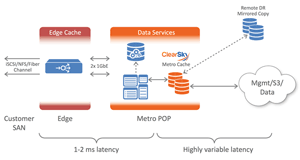 [Click on image for larger view.]
Figure 1. The ClearSky Data "Global Storage Network" architecture.
Illumio
[Click on image for larger view.]
Figure 1. The ClearSky Data "Global Storage Network" architecture.
Illumio
There was a lot of talk about micro-segmentation this year at VMworld, as VMware continues to educate its users on NSX while at the same time integrating the technology further within its SDDC vision. What some VMworld goers might not realize is that NSX is not the only option for micro-segmentation. Illumio's Adaptive Security Platform offers micro-segmentation that works on bare-metal, VMs and containers in on-premises datacenters and private and public clouds --and it does so totally independent of the network or hypervisor, and in a matter of minutes. Whether that architecture is better or worse than NSX is entirely dependent on a customer's unique situation, but it certainly sounded appealing.
VMware is now offering some of the same robust features of the Illumio platform through vRealize Network Insight, which includes IP from their acquisition of Arkin Net. However, as with most things that VMware does, it requires a few separate tools to get the job done. What I like about Illumio is that it's essentially NSX + vRealize Network Insight + some unique features. Figure 2 shows the clean, intuitive UI that helps administrators configure policies for applications they're supporting.
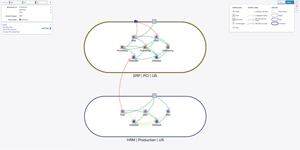 [Click on image for larger view.]
Figure 2. The Illumio UI showing the micro-segmentation of two applications.
Login VSI
[Click on image for larger view.]
Figure 2. The Illumio UI showing the micro-segmentation of two applications.
Login VSI
I've been familiar with Login VSI for quite some time. In a past life as a consultant, I used Login VSI to validate VDI designs and track down performance bottlenecks. I was excited to learn that they've got another product called Login AM (Automation Machine).
Login VSI is a European company and AM has been available on the far side of the pond for quite some time. Although they already have quite a few large customers, they're just now bringing the tool to the U.S. market.
While VSI is a tool directed at benchmarking and validating infrastructure, AM is directed at provisioning and managing it. Operations in a VDI environment is a challenging thing to tackle, but AM has powerful tools to help administrators configure and control VDI operations at scale. Figure 3 shows a screenshot of how an administrator might deploy some software packages using the tool.
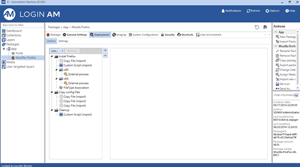 [Click on image for larger view.]
Figure 3. The Login AM console, showing a software deployment configuration.
RES Software
[Click on image for larger view.]
Figure 3. The Login AM console, showing a software deployment configuration.
RES Software
Thomas Brown told me about RES Software's RES ONE Suite, which solves the problem of getting people the resources they need to do their job properly in a timely manner while ensuring compliance and security integrity are maintained.
Consider the onboarding process. I've started a new job at a small collection of companies at this point, and I can anecdotally report that pretty much all of them paid me cold hard cash to sit there and wait while the resources I needed to do my job were provisioned. In many cases, it was weeks before I had everything I needed to complete my job responsibilities fully. Figure 4 shows how the RES ONE Suite can solve this problem (among others) and get the right digital resources to the right people at the right time.
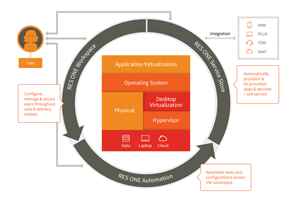 [Click on image for larger view.]
Figure 4. The RES ONE Suite architecture.
Scality
[Click on image for larger view.]
Figure 4. The RES ONE Suite architecture.
Scality
Ahh, object storage. If you haven't been hearing about object storage and the need to provide S3-compatible storage for modern applications to consume, you might be living under a rock. Most people are familiar with Amazon's implementation of this, which pioneered the principle and paved the way for on-premises object storage vendors to offer solutions that leverage the same S3 API.
Scality does exactly that. While their primary RING offering has been around for a while, what I've been exploring is their recent open-sourcing (verb) of their product called S3 Server. It's super easy to deploy and use. It can be run locally for developers to use during their development process, and deployed in the datacenter for production use. When you're ready to scale to petabytes and multiple sites, you can easily repoint your application at S3 Server's big brother - Scality RING - without changing a single line of code. Figure 5 illustrates some of the common ways that users are deploying S3 server.
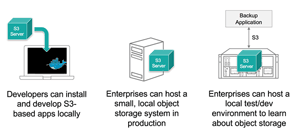 [Click on image for larger view.]
Figure 5. Some potential configurations for Scality's S3 Server.
Workspot
[Click on image for larger view.]
Figure 5. Some potential configurations for Scality's S3 Server.
Workspot
The technology we reviewed with Workspot fits squarely into the "Why didn't someone think of that before?" category. Put simply, Workspot simplifies and streamlines VDI deployment and management by putting the control plane in the cloud. Everyone who has tried it can say with certainty that, "VDI is hard."
In what they've dubbed "VDI 2.0," Workspot is aiming to make it a whole lot easier by putting a number of the challenging parts of VDI behind a SaaS-based management interface that handles many difficult aspects of "doing" VDI, especially at scale. Figure 6 illustrates which components of a traditional "VDI 1.0" deployment can be abstracted by putting Workspot in their place.
We expect that the main players like VMware and Citrix will look to go this route eventually as well, but due to sheer inertia, it's going to be a while. When combined with hyperconverged infrastructure, Workspot can help you deploy radically simple VDI environments in less than a day.
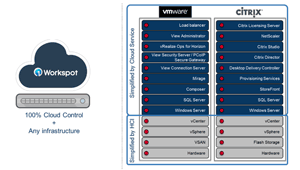 [Click on image for larger view.]
Figure 6. The dark blue sections illustrate components that can be abstracted by Workspot. They're no longer an administrator's burden to manage.
[Click on image for larger view.]
Figure 6. The dark blue sections illustrate components that can be abstracted by Workspot. They're no longer an administrator's burden to manage.
About the Author
vExpert James Green has roughly a decade of experience as an IT administrator, architect and consultant in a variety of organizations. He's highly certified, and continues to purse professional certifications to increase his breadth and depth of knowledge. He has always been passionate about writing and speaking, and discussing the marriage of cutting-edge technology and business is one of his favorite activities. He works for ActualTech Media, www.actualtech.io.